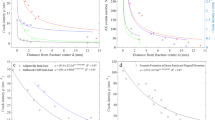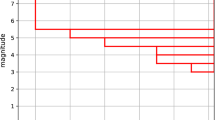Abstract
This paper analyzes earthquakes of intensity 1 or greater in Japan from 1982 to 2021 using seismic data published by the Japan Meteorological Agency. After measuring the transition of the Gutenberg–Richter law, we identified a positive correlation between the number of annual earthquakes and b values. Using mesh statistics, we also compiled the seismic energy and number of earthquakes for each mesh to confirm their power laws, the correlation between the seismic energy and the number of earthquakes, and the existence of time-reversal symmetry. We concluded that Gibrat’s law does not exist and discussed the properties that exist in its place.









Similar content being viewed by others
References
Fujiwara Y, Souma W, Aoyama H, Kaizoji T, Aoki M (2003) Growth and fluctuations of personal income. Physica A 321:598–604
Fujiwara Y, Guilmi CD, Aoyama H, Gallegati M, Souma W (2004) Do Pareto-Zipf and Gibrat laws hold true? An analysis with European firms. Physica A 335:197–216
Gutenberg B, Richter CF (1941) Geol Soc Am Spec Paper 34:1
Gutenberg B, Richter CF (1944) BSSA 34:185
Hasegawa A, Nishimura T, Sato H (2015) Seismology. Kyoritsu Shuppan Co., Ltd ((in Japanese))
Ishikawa A (2021) Statistical properties in firms’ large-scale data. Evolutionary Economics and Social Complexity), Springer, Tokyo
Japan Meteorological Agency. https://www.data.jma.go.jp/svd/eqdb/data/shindo/index.html
Mantegna RN, Stanley HE (1999) Introduction to econophysics: correlations and complexity in finance. Cambridge University Press, Cambridge
Omori F (1894) J Col Sci Imp Univ Tokyo 7:111
Pareto V (1897) Cours dEconomie Politique. Macmillan, London
Statistics Bureau of Japan (2023). https://www.stat.go.jp/english/index.html
Takayasu H (2004) Discovering econophysics. Kobunsha Co., Ltd ((in Japanese))
Utsu T (1957) Earthquake (2) 10, 35; GM 30 521(1961)
Utsu T (1997) Seismology. Kyoritsu Shuppan Co., Ltd ((in Japanese))
Acknowledgements
The authors thank a workshop called the Data-Driven Mathematical Sciences and Econophysics in the Meiji Institute for Advanced Study of Mathematical Sciences (MIMS). This study was supported by JSPS KAKENHI under Grant Nos. 21H01569, 21K04557, and 22K04609, and the Nomura Foundation for Social Science.
Author information
Authors and Affiliations
Corresponding author
Ethics declarations
Conflict of interest
The authors declare no conflict of interest regarding the publication of this article.
Ethical approval
This article contains no studies with human participants performed by any of the authors.
Informed consent
Informed consent was obtained from each individual participant included in the study.
Additional information
Publisher's Note
Springer Nature remains neutral with regard to jurisdictional claims in published maps and institutional affiliations.
About this article
Cite this article
Ishikawa, A., Fujimoto, S. & Mizuno, T. Statistical laws observed in earthquakes using mesh statistics: an econophysical point of view. Evolut Inst Econ Rev (2023). https://doi.org/10.1007/s40844-023-00255-x
Received:
Accepted:
Published:
DOI: https://doi.org/10.1007/s40844-023-00255-x




